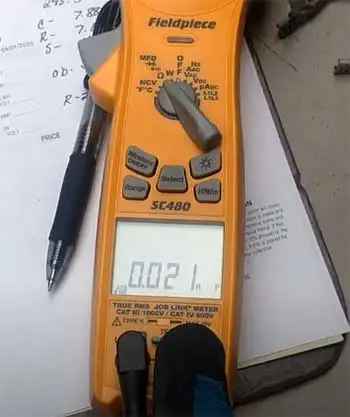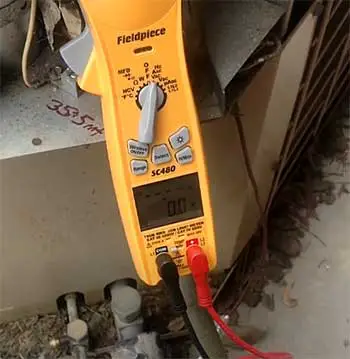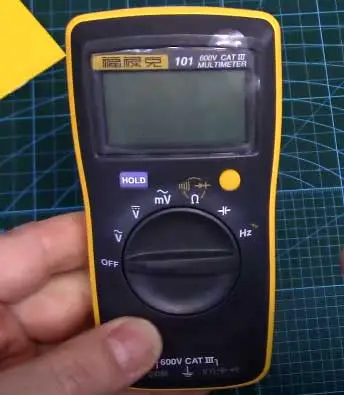As an HVAC technician, having a reliable multimeter at your side is indispensable for troubleshooting electrical issues, verifying system operation, and performing routine maintenance across residential and commercial job sites.
When it comes to multimeters built for the demands of HVAC field work, two brands stand out as go-to options: Fluke and Fieldpiece.
As leading test equipment manufacturers, both Fluke and Fieldpiece offer portable multimeters packed with specialized features for heating, ventilation, air conditioning, and refrigeration professionals.
However, these two industry leaders have notable differences when it comes to accuracy, durability, ease of use, price, and other key factors.
This in-depth Fluke vs Fieldpiece comparison examines all specifications, features, pros and cons of each brand’s most popular HVAC multimeter models.
After understanding these key contrasts, you’ll have the knowledge to decide whether a top-tier Fluke meter or more affordable Fieldpiece model makes sense for your troubleshooting needs and budget.
A Brief Comparison Table
| Specs/Features | Fluke 179 | Fluke 116 | Fluke 87V | Fieldpiece HS36 | Fieldpiece HS33 | Fieldpiece SMAN460 |
| AC/DC Voltage | 1000V | 600V | 1000V | 600V | 600V | 600V |
| True RMS | ✅ | ❌ | ✅ | ✅ | ❌ | ✅ |
| Auto-Ranging | ✅ | ✅ | ✅/Manual | ✅ | ✅ | ✅ |
| Resistance | 50 MΩ | 40 MΩ | 50 MΩ | 40 MΩ | 4 MΩ | 4 MΩ |
| Continuity | ✅ | ✅ | ✅ | ✅ | ✅ | ✅ |
| Frequency Range | 500 kHz | 50 Hz-1 kHz | 200 kHz | 1 kHz | 200 Hz | 100 kHz |
| Temperature Range | -200°C to 1090°C | -40°C to 400°C | -200°C to 1090°C | -20°C to 990°C | -20°C to 760°C | -20°C to 990°C |
| Display Counts | 6000 | 6000 | 20000 | 3999 | 2000 | 6000 |
| Special HVAC Functions | ❌ | ❌ | ❌ | Superheat/Subcool | Superheat/Subcool | Superheat/Subcool, Wireless Probes |
| Warranty | Lifetime | Lifetime | Lifetime | 1 Year (extendable) | 1 Year (extendable) | 1 Year (extendable) |
Overview of Fluke Multimeters

Known industry-wide for high-precision test instrumentation since its founding in 1948, Fluke manufactures multimeters highly regarded for their accuracy, reliability, and versatility.
While the brand offers various meters for field service, electronics, and industrial applications, three models stand out as prime selections for HVAC technicians.
Fluke 179/177
The Fluke 179 and previous generation 177 represent the gold standards for True RMS digital multimeters tailored for harsh HVAC/R field work. Highly advanced yet easy to operate, both feature:
- True RMS readings – Accurately measures non-linear signals from variable speed drives and other HVAC electronics
- Auto-ranging flexibility – Detects signals automatically across all ranges from millivolts to 1000 volts
- Large display and backlight – Clearly presents measurements in all working conditions
- Tough tested durability – Rugged design withstands drops up to 6.5 feet and carries an IP67 rating against dust and water
- Low impedance mode – Prevents false readings due to ghost voltages
- Ergonomic design – Integrated handstrap and probes with removable holster improve portability
- Wide temperature measurement – Reads from -200°C to +1090°C with appropriate thermocouple probe
With the TL175 twist guard test leads, 179 model, and general purpose temperature probe included, this Fluke combo kit provides an all-in-one solution for advanced HVAC troubleshooting needs.
Fluke 179/177 Key Specifications
- AC/DC Voltage: 1000V
- True RMS AC Voltage & Current
- Resistance: 50 MΩ
- Frequency Range: 5 Hz – 500 kHz
- Continuity Beeper: Yes (< 25 Ω)
- Display Counts: 6000
- Battery: Li-ion rechargeable battery
Fluke 116
The mid-tier Fluke 116 provides technician-grade multimeter capabilities at a more affordable price point for budget buyers. Handy features for HVAC pros include:
- AutoVolt automatic AC/DC voltage selection – Detects and sets correct voltage mode without pressing a button
- VCHEKTM LoZ low impedance function – Enables accurate voltage testing and ghost voltage detection
- Microamps mode for flame rod testing – Easily verifies and troubleshoots furnace flame sensors
- Resistance and continuity testing – Helps measure motor windings and identify opens/shorts in circuits
- Compact ergonomic design – Fits easily in your hand with integrated test lead storage
- CAT III 600V overvoltage rating – Safe for working around HVAC line voltage supplies
While not True RMS based, the 116 represents a durable and reliable HVAC multimeter priced below comparable Fieldpiece models.
Fluke 116 Key Specifications
- AC/DC Voltage: 600V
- Resistance: 40 MΩ
- Continuity: Yes
- Frequency Range: 50 Hz – 1 kHz
- Display Counts: 6000
- Battery: AA alkaline
Fluke 87V
If you require max versatility in a compact industrial grade multimeter for commercial HVAC applications or cross-field work, the Fluke 87V sets the standard. Key traits like:
- Auto and manual ranging – Automatically selects range or set manually for maximum flexibility
- Large digit display with backlight – Clearly presents test data in any lighting conditions
- Integrated thermocouple connectors – Enables temperature measurements with optional bead probes
- VCHEK LoZ – Performs accurate voltage testing and detects ghost voltages
- Min/Max recording – Captures signal spikes and variations
- Measure up to 10 amps – Tests higher current HVAC components and circuits
- Lifetime warranty – Uncommon coverage demonstrating long term reliability
Its combination of measurement parameters, accuracy, testing modes, and rugged IP67 rated waterproof/dustproof design cements the 87V’s status as an exceptional commercial-grade HVAC multimeter – albeit at a 400 USD+ cost.
Fluke 87V Key Specifications
- AC/DC Voltage: 1000V
- True RMS AC Voltage & Current
- Resistance: 50 MΩ
- Continuity: Yes
- Frequency Range: 5 Hz – 200 kHz
- Display Counts: 20000
- Battery: AA alkaline
Overview of Fieldpiece Multimeters

Founded in 1996 specifically to serve HVACR technicians, Fieldpiece develops innovative test instruments designed from real-world technician feedback.
While offering various accessories like clamp meters and leak detectors, Fieldpiece’s claim to fame lies with their specialized selection of digital multimeters for heating/cooling pros.
Their sticks, pocket portables, and wireless smart probe meters simplify measurements like superheat, subcooling, CFM, and airflow – while still providing essential voltage, current, and continuity testing capabilities.
Let’s examine Fieldpiece’s most popular models for capabilities, limitations, and value against comparable Fluke meters.
Fieldpiece HS36 Stick Multimeter
Featuring specialized functions tailored for HVAC combined with staple digital multimeter capabilities, the value-packed HS36 stick meter sets the standard for straightforward operation. Key traits include:
- Superheat and subcooling readings – Enable fast troubleshooting of TXVs and refrigeration issues
- True RMS mode – Provides accurate measurements on complex HVAC system signals
- Auto ranging scales – Automatically set measurement range for convenience
- Durable compact form – Withstands 6-foot drops yet fits easily in your hand or pocket
- Large display with backlight – Allows easy reading in any conditions
- CO measurement with audible alert – Identify potential carbon monoxide safety hazards for technicians and homeowners
- Rugged probes – Test leads withstand twisting and play from daily use
- Inexpensive price – Represents major value at around 150 USD
While not loaded with automatic features or highest accuracy circuitry, the HS36 provides key functionalities HVAC techs utilize day in and day out – all in a simplified compact package priced below comparable offerings from Fluke.
Fieldpiece HS33 Compact Stick Multimeter
If affordability ranks higher than advanced capabilities on your wish list, then the Fieldpiece HS33 makes an appealing option at just 98 USD.
Designed for apprentice technicians or home HVAC owners on a strict budget, the compact HS33 stick multimeter includes:
- Superheat and subcooling readings – Built-in calculations remove math struggles
- Auto ranging measurement scales
- Durable compact housing – Withstands heavy daily use
- Intuitive button layout – Easy to operate for fast measurements
- CO monitoring – Alerts users of unsafe levels
- Continuity detection – Helps identify broken wiring or component failures
- Basic DC voltage and resistance testing – Covers basics though max voltage/resistance range lags higher models
There’s no doubt you compromise long term durability, accuracy, advanced functions, and proprietary accessories when choosing the ultra-affordable HS33. However, it’s perfectly capable for residential service calls or home DIY use.
Fieldpiece SMAN460 4-Port Wireless Multimeter
On complex HVAC troubleshooting jobs where you need to monitor multiple sensor readings across an equipment system simultaneously, the Fieldpiece SMAN460 wireless meter paired with smart probes empowers you to diagnose problems quickly.
The SMAN460 features:
- Four measurement ports – Connect up to 4 smart probes for independent wireless readings
- Over 25 compatible smart probes – Choose from temperature clamps, current clamps, psychrometers, vacuum and pressure transducers, velometers, anemometers, leak detectors, and more
- Large graphical display – Clearly track all readings together or individually
- 1000 ft wireless range – Monitor test points across entire buildings and rooftops
- Rechargeable li-ion battery – Built to last all day long
- Withstands drops to concrete – Durable IP54 rated housing
- True RMS mode – Accuracy testing modern equipment
- Superheat and subcooling calculation modes
Alone the SMAN460 can tackle all standard electrical, temperature, capacitance, and frequency measurements.
But paired with compatible smart sensor probes, it’s capable of advanced field diagnostics not possible or extremely time consuming traditionally. Of course, this top functionality and flexibility comes at a steep 500 USD+ total investment with probes.
Key Measurement Specification Comparison
Now that you have a broad overview of the specialized or advanced features of both brand’s leading HVAC multimeter models, how do basic measurement capabilities compare?
Check out this Fluke and Fieldpiece multimeter spec showdown:
AC/DC Voltage Testing

- Fluke 179: 1000V max
- Fieldpiece HS36: 600V max
- Advantage: Fluke 179
True RMS Readings
- Fluke 179: Yes, rms responding DMM
- Fieldpiece HS36: Yes + dedicated rms mode button
- Advantage: Tie – both offer true RMS capabilities
Resistance Measurement
- Fluke 179: 50 million ohm max
- Fieldpiece HS36: 40 million ohm max
- Advantage: Fluke 179
Continuity Detection
- Fluke 179: Yes, w/ beeper < 25 Ω
- Fieldpiece HS36: Yes
- Advantage: Tie – both offer continuity detection
Frequency Measurement
- Fluke 179: 5 Hz to 500 kHz
- Fieldpiece HS36: 45 Hz to 1 kHz
- Advantage: Fluke 179 – far greater frequency range
Temperature Measurement
- Fluke 179: -200 °C to +1090 °C
- Fieldpiece HS36: -20 °C to 990 °C
- Advantage: Tie – both support required HVAC temp ranges
Logging, PC Interface, Wireless
- Fluke 179: Optional FC wireless adapter
- Fieldpiece HS36: None
- Advantage – Fluke 179 – supports optional proprietary wireless transfer capabilities
Based on a head-to-head matchups of key measurement parameters, Fluke models like the 179 unquestionably win out in terms of range, accuracy, advanced capabilities, and flexibility compared to the value-driven HS36.
However, Fieldpiece meters tailor their features sets directly to routine testing HVAC techs conduct.
Let’s examine additional factors like durability, ease of use, pricing, and warranties where choices become less obvious.
Durability Comparison
In regards to physical construction and weatherproof/drop standards, both brands rate closely for models targeted at HVAC field work.
The mid-tier Fluke 116, high-end 179, and leading Fieldpiece HS36 all meet 6.5+ foot drop tests and at least an IP54 rating against dust and water ingress per IEC inspection standards. As a result, expect reliable mechanical performance for years of accidental drops into truck beds or on rough commercial job sites.
Slight advantages do exist however:
- The Fluke 179 flagship earned an IP67 rating meaning it’s fully dust tight and can withstand 30 minutes immersions in water up to 1 meter deep. The HS36 is only IP54 rated.
- Fieldpiece test leads feel slightly less rugged – being thinner and more prone to kinking from twisting compared to durable Fluke test leads. Replacement leads are readily available however.
For the vast majority of heating and cooling service calls under typical conditions, both brands stand evenly when it comes to physical construction. Fluke simply provides extra assurance for max weatherproofing and outright abuse.
Ease of Use Comparison
Multimeters balance wide measurement capabilities with ease of operation via their user interfaces. When evaluating Fluke vs Fieldpiece models for HVAC applications, preferences emerge:

- For broad varied usage across electronics troubleshooting fields, most technicians would rate Fluke meters as easier to use. Their larger displays with clear auto-ranging readouts, smooth rotary dials, and standard labeling simplify interpretation. The pocket-sized 116 for example excels here.
- For users concentrated almost exclusively on HVAC service, Fieldpiece meters provide streamlined operation thanks to:
- Dedicated buttons for activating Superheat, Subcooling, and other pre-configured modes essentail to heating/cooling work.
- Simplified button clusters with built-in ranges as opposed to complex rotary dial selection on Fluke units.
So technicians crossing over between various specialties may find Fluke units work better out of box. But for those squarely focused on HVAC, Fieldpiece meters offer efficient ergonomics and measurement activation.
Pricing & Value Comparison
When making any buying decision, cost invariably factors into the calculation. Given their reputation for high-end accuracy and ruggedness earned across industries, Fluke units universally cost more than Fieldpiece models with similar functionality.
As prime examples:
- The flagship Fluke 179 retails around $450, while the Fieldpiece HS36 costs roughly $150 – a $300 premium for the 179.
- The compact 116 Fluke sells for approximately $190 vs $90 for the budget-oriented Fieldpiece HS33.
There’s no question you pay a sizeable mark-up for proven Fluke quality. However, the adage holds true: you get what you pay for.
While Fieldpiece meters offer respectable value matching functionality to lower price tags, Fluke models deliver greater measurement range/accuracy, advanced features, reliability, warranties, and long working lifespans worth price premiums to serious technicians.
Paying $300+ more for a 179 over an HS36 buys peace of mind and high-end capability difficult to replicate at consumer price points.
For homeowners, entry-level HVAC mechanics, or techs on tight budgets, Fieldpiece meters offer your most affordable path to essential voltage/current/Superheat testing in compact form factors.
Just expect to compromise certain accuracy, power user features, and long term robustness compared to a 179.
Warranty Comparison

When gauging expected working lifespan before replacement, warranty coverage provides useful insight into how confidently the manufacturer stand’s behind their reliability claims.
Here as well, Fluke outpaces Fieldpiece.
While Fieldpiece meters as a whole perform respectably for years when following operating limits, their standard warranty only covers manufacturing defects for 1 year after purchase.
Extensions to 2 and 3 years are offered with product registration.
In contrast, Fluke’s industry-best Lifetime Warranty guarantees repair/replacement for ANY failures outside excessive abuse across all 177/179 calibration specifications.
Demonstrating confidence even small resin components and switches won’t degrade for decades, this remains uncommon for compact handheld electronics exposed to field conditions.
For budget-focused buyers less expectant of 10+ years reliable operation, Fieldpiece’s standard 1 years coverage should suffice though. Pay the Fluke premium if seeking a meter to use continuously across your entire career.
Closing Remarks
Given the detailed functionality and specification comparison between popular Fluke digital multimeters and Fieldpiece alternatives tailored for HVAC applications, which brand wins out as most ideal for heating/cooling technicians?
For Apprentice and Home HVAC Owners
If launching an HVAC career or requiring basic system troubleshooting as a homeowner, I recommend the Fieldpiece HS33 as the best value multimeter. Priced below $100, it includes fundamental measurement modes like voltage, Resistance, Continuity, Superheat calculations, and CO monitoring in a compact, intuitive format.
Downsides of lower accuracy, durability, and 1 year warranty are minimized if used gently across residential maintenance needs – not subjected daily to commercial equipment abuse.
For Residential and Light Commercial HVAC Technicians
Technicians earning a living primarily across residential service calls, light commercial sites, or basic HVAC installations should strongly consider the Fieldpiece HS36 stick multimeter for $150.
With True RMS, superheat/subcool modes, durable IP54 rated body, and sensible button layout, the HS36 simplifies daily tasks like diagnosing bad compressor windings or plotting expansion valve performance. DC voltage, microamp, and continuity cover standard circuit debugging as well.
Unless you require advanced measurement ranges or cross-disciplinary versatility, the HS36 delivers capable performance and special HVAC functions that speed up work compared to generic Fluke models in the sub $200 range.
For Commercial/Industrial HVAC Technicians
For licensed technicians servicing complex commercial equipment, large-scale HVAC systems across hospitals, industrial facilities, etc – the Fluke 179 truly earns its place as the industry gold standard multimeter for HVAC.
Unmatched accuracy and advanced True RMS flexibility combined with extremeruggedness to withstand decades of daily abuse makes the $450 Fluke 179 the perfect investment.
Alternative models like the Fieldpiece HS36 frankly lack the high-end capability necessary for balancing air handlers, testing motor windings, precision sensor measurement, and adjustment of variable frequency drives found across commercial sites.
The same applies to sophisticated electronics technicians regularly debugging circuit boards or troubleshooting HVAC controller logic where rock-solid precision and advanced features prove essential.
For these demand applications, the Fluke 179 stands alone as the de facto HVAC multimeter for anyone earning income dependent on accurate system
